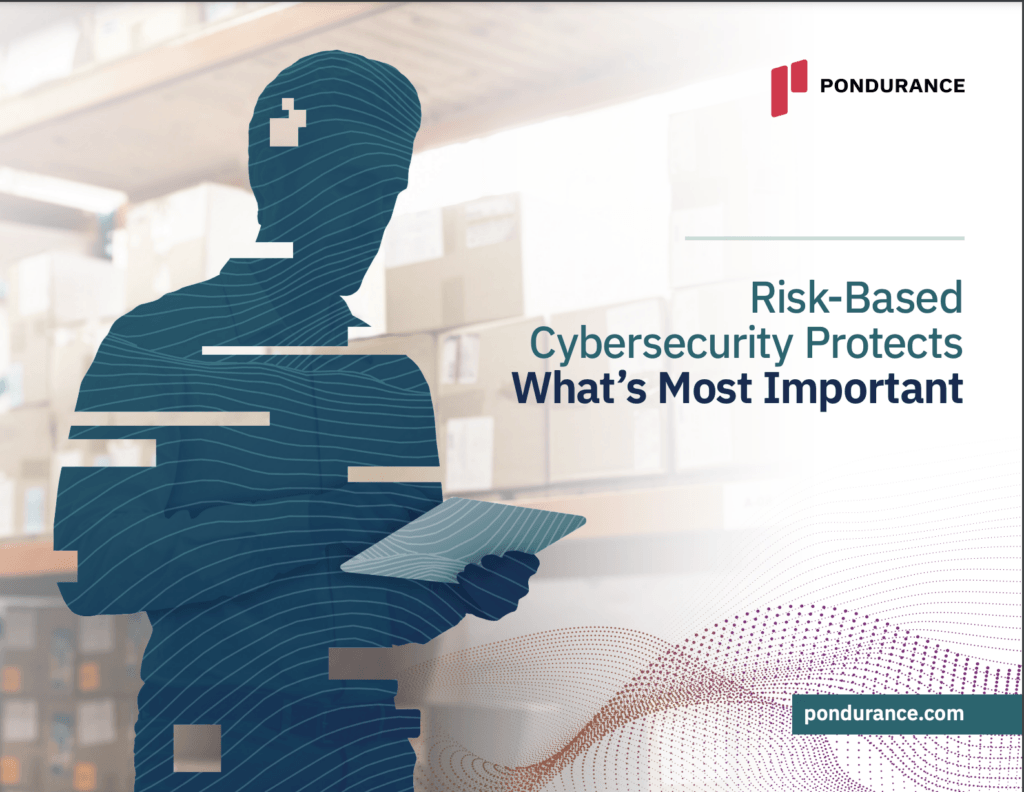Our privacy policy is located here.
Risk-Based Cybersecurity
Your cybersecurity approach should align with your company’s objectives, outcomes, and risks — making a risk-based approach to cybersecurity the best strategy for your business.
Defend What's Most Important
With a Risk-Based Cybersecurity Approach

Learn more about our risk-based approach, and dynamic defense methodology
Dustin Hutchison, Ph.D.
Protect What Matters Most with Risk-Based Cybersecurity
Pondurance — the first and only MDR provider to be built around a risk-based approach — believes a risk-based approach is the best way to protect clients from threats and reduce their exposure to attacks.

Learn more about a risk-based MDR approach
an Interview with ISMG and Doug Howard



Risk Based Cybersecurity Approach
The digital landscape is constantly evolving, and with it, the threats lurking in the cyber world are also becoming increasingly complex and sophisticated. To effectively safeguard against these threats, Pondurance champions a unique approach known as the risk-based cybersecurity approach. Unlike conventional cybersecurity methodologies, which treat all potential threats with equal priority, this approach advocates a more focused, strategic, and financially viable solution by identifying and protecting the most sensitive and valuable data assets based on their assessed risk factors.
Further delving into the nuances of a cybersecurity risk-based approach, a pivotal component lies in its risk assessment perspective. Cyber threats are gauged based on their potential business impact, with resources then allocated accordingly to manage the risks. This prioritization strategy allows organizations to get the most out of their cybersecurity spending, reduce the possible economic fallout of a cyber attack, while providing robust protection for their most critical digital assets.
Inherent in a risk based cybersecurity approach, is the shift from a purely defensive posture to a proactive, intelligence-driven strategy. It entails comprehensive risk assessment, taking into consideration the overall digital landscape of the organization, the economic implications, and the evolving threat environment. It empowers businesses to stay ahead of potential threats and mitigate them before they manifest into serious data breaches or system infiltrations.
Bringing the concept home, Pondurance extensively applies the principles of a risk-based approach to cybersecurity in crafting and delivering bespoke cyber security solutions for their clients. Their understanding and adaption of this approach demonstrates a forward-thinking perspective and a commitment in ensuring optimum cybersecurity for their clients by focusing not merely on the security of their systems, but on the potential risks they pose.
In the end, a risk-based cybersecurity approach in cyber security offers a more cost-effective, efficient, and powerful method of managing and mitigating cyber threats. It resonates with the philosophy of Pondurance, creating a cybersecurity landscape that is proactive, strategic, and ultimately, secure.
Core Categories of a Risk-Based Approach
As cybersecurity threats continue to evolve, strategies to combat these risks must also advance in tandem. One of these methods is the risk-based security approach, a comprehensive procedure steeped in layers that brings simmering threats to light before they reach a boiling point. Furthermore, Pondurance ensures that every venture within the area of risk-based security is well-considered and weighed against its potential impact on the business.
A risk-based approach to cybersecurity has core categories which make it highly effective in proactively protecting enterprises. To begin, a risk assessment is performed to evaluate the extensibility of cyber threats a business may be exposed to. By utilizing the cybersecurity risk assessment, assets that are most vulnerable to attacks can be swiftly identified and secured. This practice begins with a thorough insight into the company’s processing systems, data, and network security, helping businesses prioritize their most sensitive data.
It is important to think of risk assessments as not a “one and done” but as an ongoing part of your cybersecurity program. With a risk-based approach from Pondurance, risk assessments are conducted at regular intervals enabling their clients to document risk reduction overtime. In addition, with the operationalization of risk assessments into their cybersecurity program, Pondurance clients can adapt and adjust their programs as the landscape evolves or their needs change.
Building on this, another key tenet of this approach is threat hunting. In an era where cybercrimes are prepared and agile, waiting for alerts is a game of Russian Roulette. Instead, proactive measures are employed to anticipate potential attacks before they can inflict lethal operational wounds. Thorough and successful threat hunting ultimately enhances a company’s defensive measures, strengthening the bulletproof vests that secure its vital systems.
Derived from these principles is the methodology of risk-based Managed Detection and Response (MDR). Unlike conventional methods that attempt to build an impenetrable fortress, a risk-based MDR centers on identifying most attractive targets to cybercriminals, and subsequently fortifying those targets via competent cybersecurity measures. Additionally, through Pondurance’s managed cybersecurity services, proactive techniques are adapted for seamless integration with an organization’s existing security infrastructure, improving the overall operation while reducing associated costs.
Another profound category that emerges from the risk-based approach to cybersecurity is cyber risk management. This involves implementing a comprehensive mitigation strategy in line with the assessed risks as part of the risk-based security approach. The results? Companies are better equipped to prioritize cyber risks, ensuring attention is given to the most alarming threats, all while optimizing their resource allocation.
Pondurance leverages these core categories of a risk-based approach to offer robust solutions. By considering each of these areas as an integral part of their service offerings, Pondurance has set the stage for effective, tailored, and dynamic cybersecurity. The savings – both in fiscal terms and in opportunities for sustained business continuity – are testament to the efficacy and efficiency of a risk-based approach to cybersecurity.
Navigating Cybersecurity Risks with a Risk-Based Approach
Understanding and navigating cybersecurity risks with a risk-based approach is a critical necessity in the present digital era. The complexity and ever-evolving nature of cybersecurity threats demand a comprehensive and proactive approach to risk management. A risk-based approach aligns more perfectly with the strategic needs of the organization, enabling targeted mitigation strategies and efficient allocation of resources. This method has become an indispensable component of Pondurance’s service offerings, ensuring clients obtain the right cybersecurity arsenal suited for their unique vulnerabilities.
Cybersecurity risk management is indeed complex, particularly due to the increasing array of threat vectors and the intensification of digital interconnectivity. Every entity on the internet, from individuals to multinational corporations, is a potential target and inadvertent facilitator of cyber threats. This complexity can be better navigated with strategic planning and a well-articulated risk-management framework — critical elements of a risk-based approach. By proactively identifying the risks, interpreting their impacts, and applying necessary controls, organizations can attain higher resilience and lower susceptibility to cyber attacks.
Adopting the risk-based approach to cybersecurity has substantial benefits. Firstly, it is cost-efficient as it aids in pinpointing and prioritizing the organization’s most prized and sensitive data, thereby protecting what matters most. Secondly, the NIST (National Institute of Standards and Technology) provides a practical guide, embodied by its Cybersecurity Framework. NIST cybersecurity key risk indicators examples include detecting malware, monitoring unauthorized users’ activity, and analyzing threats linked to intellectual property. These practical guides help in assessing the efficacy of implemented risk management strategies.
Mckinsey’s report on the risk-based approach to cybersecurity complements the effectiveness of this approach. It affirms that navigating cybersecurity risks with a risk-based approach can help businesses keep pace with increasingly sophisticated threats by proactively identifying and addressing vulnerabilities. However, the potential challenges arise when organizations struggle with assigning risk scores accurately or fail to align risk mitigation strategies with business objectives, stressing the importance of technical expertise and strategic oversight.
Pondurance thrives on its commitment to assist businesses improve their cybersecurity posture through a risk-based approach. By tailoring comprehensive and proactive management strategies, we aim to keep the digital landscape of our clients secure, resilient, and compliant. Our services enhance not only cybersecurity but also business continuity, ensuring a harmonious balance between protection, productivity, and profitability.
The Future of Cybersecurity: A Risk Based Approach
The future of cybersecurity is intrinsically linked with a risk-based approach, an integral component of Pondurance’s service offerings. Organizational dynamics tend to change dramatically due to rising digital threats, underscoring the necessity of a pragmatic, proactive, and dynamic strategy for cybersecurity.
Pioneering the vanguard of this digital evolution, Pondurance articulates the relevancy and functionality of a risk-based approach to cybersecurity. The intentions are clear and precise—to optimally allocate resources, prioritize sensitive data, and systematically eliminate potential cyber threats. Unquestionably, risk-based approach cybersecurity redefines the rulebook, offering an effective resistance to cyber adversaries.
Adopting a risk-based approach to risk assessment provides an amplified, in-depth perception of potential vulnerabilities, honed to address the unique topography of individual cybersecurity landscapes. This methodology encompasses a series of organized risk-based approach steps designed to identify, prioritize, and mitigate potential cybersecurity risks. Furthermore, adhering to a risk-based approach can lead to substantial financial savings. By prioritizing acute risks, businesses are better equipped to deploy their resources more efficiently—largely reducing unnecessary expenditure while enhancing overall security effectiveness.
Understanding and assessing cybersecurity risk is of paramount importance in today’s interconnected digital ecosystem. A comprehensive overview of potential threats can enable organizations to make informed and effective cybersecurity decisions. To that end, Pondurance offers risk-based approach example scenarios, helping organizations identify their most critical risks and create appropriate deterrents.
Finally, the future of cybersecurity: a risk-based approach—including its potential developments, is set to transform the cybersecurity landscape. As digital threats become increasingly sophisticated, a risk-based approach is vital in staying a step ahead. The evolution of contemporary digital threats necessitates continual adjustments to risk management strategies, allowing organizations to efficiently tackle emerging digital challenges. Irrespective of the threat or complexity, Pondurance tailors risk-centric solutions designed to evolve and adapt along with the rapidly shifting cybersecurity terrain.
